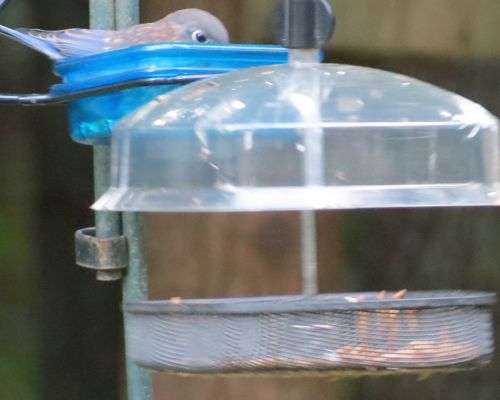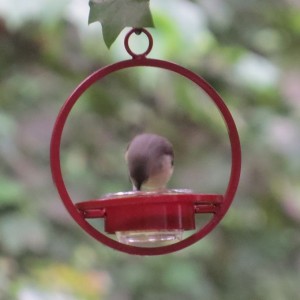Opportunistic Robins and More Wait Below this Mealworm Feeder

See them in the back, on the right side? Escapees! It’s problematic enough when cat birds and cardinals and warblers start in on your live worms, after all-they’re meant for the bluebirds. Recent fledges are learning to use the feeders, so it’s a real bummer when they figure it out and it’s empty 🙁
Robins, chipping sparrows, cardinals, towhees, chickadees, titmice and still others have learned that sometimes it rains worms. They’ll sit below this screened mealworm feeder and wait for the manna to fall… and it does.
Not to say the design is sub-par, just maybe not the best choice for offering live mealies. Dried worms and other bluebird treats are ideal in this hanging feeder, but the tooth (screen texture) gives the live ones a good grip and path to exit stage left!
The new steel Orb Feeder features an acrylic cup, a nice smooth surface that keeps worms put, that is until titmice and chickadees discover them. And the blue dish shown above is also a nice smooth surface, one from where worms can not escape.
Something we’ve experimented with this season (and is quite successful) is offering more of the dried worms – much more economical. But the trick is to soften them first so that parents will feed them babies. Steeping dried meal worms in boiling water for about ten minutes-then draining, is ideal if you’re a backyard bird freak like us 🙂
So a good basic rule of thumb is that live worms do much better when placed on a smooth surface! Should too many worms be disappearing altogether, an enclosed feeder is likely best. Bluebirds are one of the few who will “fly-in” a feeder. Without fail, Carolina wrens are always the first to figure it out!
With so many new fledges out and about, it’s a great time to try offering mealworms if you never have in the past. One way to stretch worms and make them lat longer is to use a mixture. One of our recipes includes a no-melt suet cake (crumbled), shelled peanuts and a few sunflower hearts… the birds love it!

